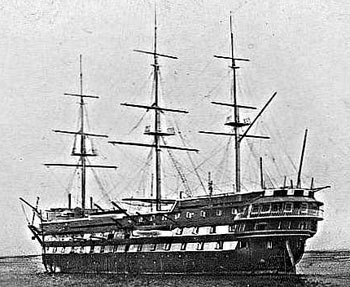|
HISTORY
 On
19 April 1858, a committee was formed by members of the
Mercantile Marine Service Association (M.M.S.A.) to establish a
training ship on the Mersey, to train boys to become officers in
the Merchant Navy. The Admiralty offered the frigate Conway,
a coastguard ship at Devonport which, on its arrival in the
Mersey, was moored off Rock Ferry. The school was opened on the
1 August 1859. On
19 April 1858, a committee was formed by members of the
Mercantile Marine Service Association (M.M.S.A.) to establish a
training ship on the Mersey, to train boys to become officers in
the Merchant Navy. The Admiralty offered the frigate Conway,
a coastguard ship at Devonport which, on its arrival in the
Mersey, was moored off Rock Ferry. The school was opened on the
1 August 1859.
The original Conway was replaced after two years by HMS
Winchester (renamed Conway) and in 1876 she was in
turn replaced by HMS Nile, a vessel designed by Sir
Robert Seppings, one of Britain's finest naval architects. She
remained in the Mersey until 1941 when she was moved to the
Menai Straits to avoid the Blitz. In 1953, whilst being towed to
Birkenhead for a refit, she was grounded near the Menai
Suspension Bridge and broke her back. Soon after she caught fire
and had to be broken up.
From 1953 to 1974 the HMS Conway Cadet Training School
flourished as a shore establishment based at Plas Newydd,
Anglesey, and in 1968 the school was given voluntary aided
status. The British Shipping Federation (B.S.F.) took
responsibility for the nautical training and placements, while
Cheshire Education Authority assumed charge of the general
education side. However, its closure was precipitated by the
decline of Britain's Merchant Fleet, and on the 11 July 1974,
the last 85 cadets laid up the Colours in Liverpool's Anglican
Cathedral.
The average time spent by Conway cadets was two or three
years. They normally entered between the ages of 12 and 15
years. Eminent cadets included John Masefield (1891-1953) who
wrote the Conway's history in 1933 and again in 1953;
Captain Matthew Webb, the first man to swim the channel in 1875;
Kenneth Shoesmith, marine artist (d.1939), as well as many
eminent captains. |